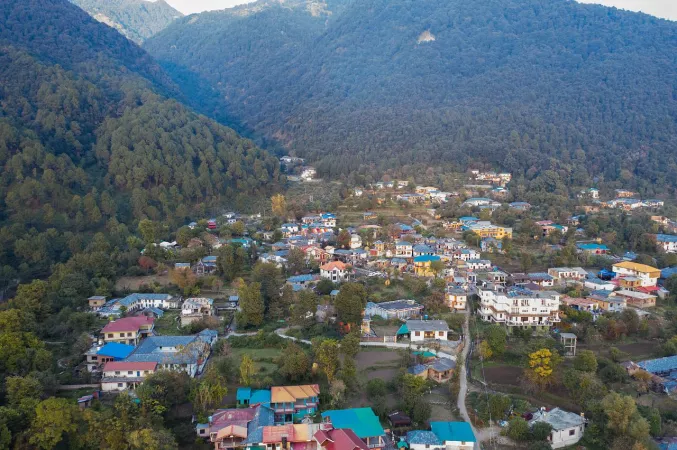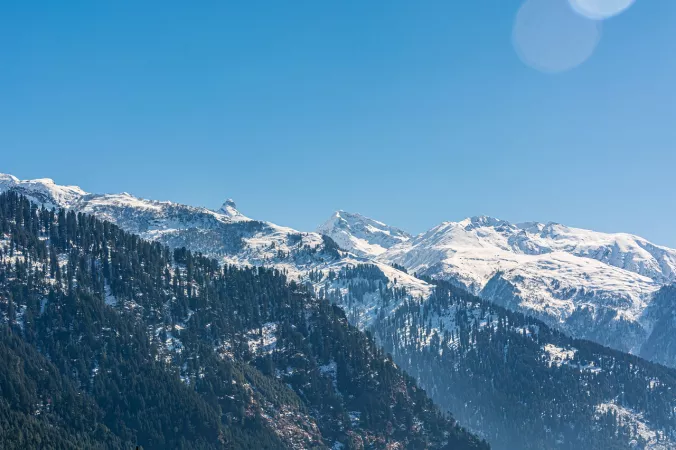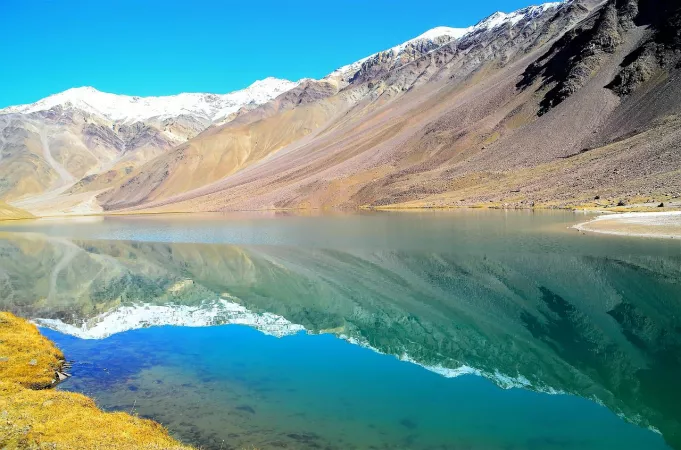Hi User
Navigation
Chamba
Kanatal . Uttarakhand . India
Duration
2 to 4 Days
2 to 4 Days
Best time to visit
Mar-Jun, Sep-Nov
Mar-Jun, Sep-Nov
Theme
Hill Station, Heritage
Hill Station, Heritage
Chamba Travel Guide
Chamba, located in the picturesque state of Himachal Pradesh in India, is a charming town renowned for its ancient temples, stunning landscapes, and rich cultural heritage. Nestled amidst the majestic Himalayas, Chamba boasts a history that dates back to the 2nd century BC, making it a treasure trove of historical significance. The town's architecture reflects a blend of Hindu and Mughal styles, adding to its allure. Chamba is famous for its annual Minjar fair, which celebrates the harvest season and is a vibrant display of local culture.Top Attractions in Chamba
- Chamba Palace
- Laxmi Narayan Temple
- Bhuri Singh Museum
- Khajjiar
- Rang Mahal
Chamba is Famous for
Chamba is most famous for its ancient temples, stunning natural beauty, and vibrant cultural festivals.Top Attractions in Chamba
- Explore the historic Chamba Palace
- Visit the intricately carved Laxmi Narayan Temple
- Discover the rich heritage at the Bhuri Singh Museum
- Experience the mini-Switzerland of India at Khajjiar
- Marvel at the architectural beauty of Rang Mahal
What's Great about Travelling to Chamba?
- Perfect destination for nature lovers
- Rich cultural experiences
- Great for adventure enthusiasts
What's Not So Great about Travelling to Chamba?
- Limited nightlife options
- Can be crowded during peak tourist seasons
- Limited shopping opportunities
Travel Tips for Chamba
- Carry warm clothing, even in summers
- Respect local customs and traditions
- Book accommodations in advance
Important Chamba trip information
- Ideal Duration: A minimum of 2-3 days is ideal to explore Chamba.
- Best Time to Visit: The best time to visit Chamba is from March to June and September to November.
- Nearby Airports and Railway Stations: The nearest airport is in Kangra, and the closest railway station is in Pathankot.
4 days & 3 nights
4.1 (18)
Family Tour Package Of Chamba-Chamba Tour Package Of 3N 4D
Chamba
Tour package by India Escapes
Verified
INR 22,857 SAVE INR 6,857
INR 16,000 /Adult
3 days & 2 nights
4.1 (18)
3 Days In Chamba-Chamba Tour Package Of 2N 3D
Chamba
Tour package by India Escapes
Verified
INR 22,857 SAVE INR 6,857
INR 16,000 /Adult
3 days & 2 nights
5 (20)
3 Days In Chamba-Chamba Tour Package Of 2N 3D
Chamba
Tour package by Trip Charm
Verified
INR 36,000 SAVE INR 9,000
INR 27,000 /Adult
5 days & 4 nights
Romantic Trip Of Chamba-Chamba Honeymoon Tour Package Of 4N 5D
Chamba
Tour package by SunRaj Tours & Travel
Verified
INR 32,667 SAVE INR 8,167
INR 24,500 /Adult
5 days & 4 nights
4.1 (18)
Romantic Trip Of Chamba-Chamba Honeymoon Tour Package Of 4N 5D
Chamba
Tour package by India Escapes
Verified
INR 22,857 SAVE INR 6,857
INR 16,000 /Adult
3 days & 2 nights
4.1 (18)
3 Days In Chamba-Chamba Tour Package Of 2N 3D
Chamba
Tour package by India Escapes
Verified
INR 18,750 SAVE INR 3,750
INR 15,000 /Adult
FAQ's on Chamba
Q1: What is the best time to visit Chamba?
Chamba is best visited during the summer months from March to June when the weather is pleasant for exploring the region's natural beauty. Avoid the monsoon season from July to September due to heavy rainfall. Winter, from October to February, offers a different charm with snow-capped mountains, but some areas may be inaccessible. Consider visiting during local festivals like the Minjar Mela in July or the Suhi Mata Mela in April for a cultural experience.
Q2: Do I need a visa to travel to Chamba?
Most tourists visiting Chamba will require a valid Indian visa. However, if you are a citizen of a few select countries, you may be eligible for visa-on-arrival or e-visa facilities. It is advisable to check with the Indian embassy or consulate in your country for specific visa requirements and any recent updates before your trip to Chamba.
Q3: What are the must-visit attractions in Chamba?
Chamba is known for its stunning architecture, including the Lakshmi Narayan Temple, Bhuri Singh Museum, and the Chamba Palace. Nature lovers should explore the Khajjiar Lake, often referred to as the "Mini Switzerland of India," and the Kalatop Wildlife Sanctuary. Don't miss the ancient temples of Chamunda Devi and Bajreshwari Devi for a spiritual experience. Trekking in the Dhauladhar and Pir Panjal ranges is also popular among adventure enthusiasts.
Q4: Is Chamba a safe place to travel?
Chamba is generally a safe destination for travelers. However, like any other place, it is advisable to take common precautions such as avoiding isolated areas at night and keeping your belongings secure. Be cautious in crowded places to prevent pickpocketing. Stay informed about local news and follow any travel advisories that may be in place during your visit to Chamba.
Q5: What is the local currency in Chamba and can I use credit cards?
The local currency in Chamba is the Indian Rupee (INR). While credit cards are accepted in some hotels, restaurants, and larger stores in urban areas, it is recommended to carry cash for smaller establishments and markets. ATMs are available in Chamba town, but it is advisable to carry sufficient cash, especially when traveling to remote areas.
Q6: What is the local cuisine like in Chamba?
The cuisine of Chamba is influenced by Himachali and Punjabi flavors, offering dishes like Madra, Sidu, and Chha Gosht. Don't miss trying the local specialty, Chha Meat, made with marinated lamb cooked in yogurt-based gravy. Vegetarians can savor dishes like Chana Madra and Babru. For a sweet treat, indulge in Mittha, a traditional sweet dish made with sweetened rice and dry fruits. Be sure to try local teas like Kangra tea for a delightful culinary experience in Chamba.
Q7: What transportation options are available in Chamba?
In Chamba, transportation options include public buses, taxis, and auto-rickshaws for local travel. Renting a car or hiring a private cab is also a convenient way to explore the region. Due to the hilly terrain, road travel may take longer than expected, so plan your journeys accordingly. Shared jeeps and buses are common for intercity travel. For a scenic experience, consider the Himachal Road Transport Corporation (HRTC) buses that connect Chamba to nearby towns and cities.
Q8: Are there any cultural norms or etiquette I should be aware of when visiting Chamba?
When visiting Chamba, it is important to respect the local culture and customs. Dress modestly, especially when visiting religious sites and interacting with locals. Remove your shoes before entering temples and other sacred places. Greet people with a respectful "Namaste" and seek permission before taking photographs of individuals. Avoid public displays of affection as it may be considered inappropriate. When dining with locals, wait to be seated and wash your hands before and after the meal. Embrace the local traditions and show appreciation for the rich cultural heritage of Chamba during your visit.
Q9: I am a travel agent. How can I buy travel leads of Chamba?
Register yourself as a travel agent at agents.tripclap.com and then you can buy travel leads to Chamba once your account is approved. For more details contact our support team at +91-8069186564 or support@tripclap.com
Certified
We accept (more)
Members of
Media Recognition
Trusted Partners
Award
Copyrights © TripClap. All Rights Reserved



